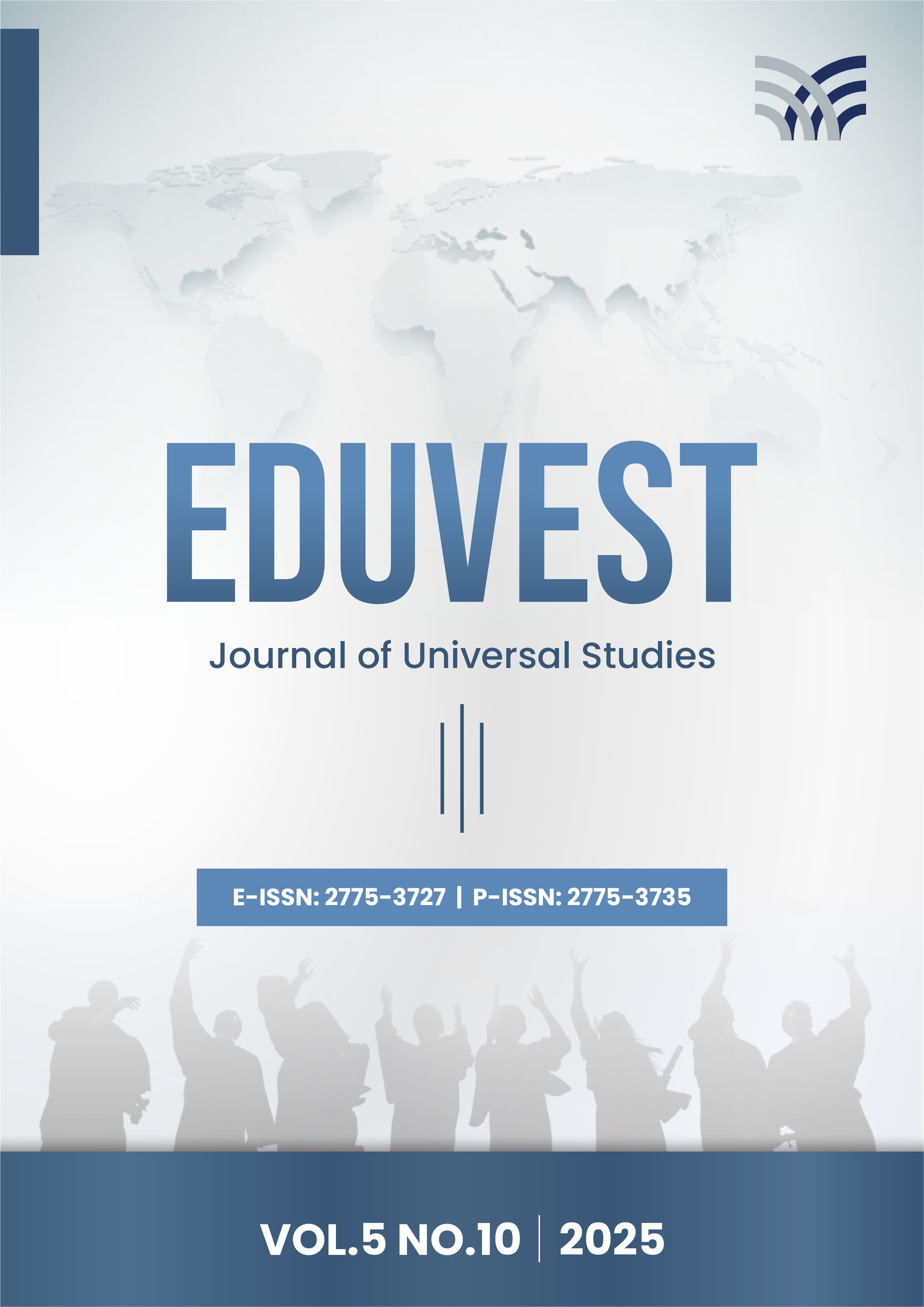Factors Influencing Visit Intention in Medical Tourism in Indonesia
##semicolon##
https://doi.org/10.59188/eduvest.v5i10.52202##semicolon##
Theory of Planned Behavior##common.commaListSeparator## visit intention##common.commaListSeparator## destination image##common.commaListSeparator## electronic word of mouth##common.commaListSeparator## medical tourismAbstrakt
Public health awareness has grown alongside technological progress, as broader access to information now enables individuals to easily obtain health knowledge from diverse sources. This study aims to examine how attitude, subjective norms, perceived behavioral control, destination image, electronic word of mouth, and perceived risk influence medical tourism visit intention. This research seeks to provide a more comprehensive understanding of the factors influencing individuals’ intention to engage in medical tourism abroad. The study employed the PLS-SEM method. Data from 304 respondents were collected cross-sectionally using an online questionnaire. The results of this study confirm the hypotheses regarding the relationships between attitude, subjective norms, perceived behavioral control, electronic word of mouth, and destination image with visit intention. All five variables individually have a significant positive correlation with visit intention. The findings of this study support the improvement of attitude and subjective norms as priorities in developing Indonesia’s medical tourism sector.
##submission.citations##
Abubakar, A. M. (2016). Does eWOM influence destination trust and travel intention: A medical tourism perspective. Economic Research-Ekonomska Istrazivanja, 29(1), 598–611. https://doi.org/10.1080/1331677X.2016.1189841
Agrawal, A., & Pi, Y. (2023, May 4). Medical tourism: Turning the tide for Indonesian patients. The Jakarta Post. https://www.thejakartapost.com/paper/2023/05/04/medical-tourism-turning-the-tide-for-indonesian-patients.html
Ajzen, I. (1985). From intentions to actions: A theory of planned behavior. In J. Kuhl & J. Beckmann (Eds.), Action control (1st ed.). Springer. https://doi.org/10.1007/978-3-642-69746-3
Ajzen, I. (1991). The theory of planned behavior. Organizational Behavior and Human Decision Processes, 50(2), 179–211. https://doi.org/10.1016/0749-5978(91)90020-T
Ajzen, I. (2002). Perceived behavioral control, self-efficacy, locus of control, and the theory of planned behavior. Journal of Applied Social Psychology, 32(4), 665–683. https://doi.org/10.1111/j.1559-1816.2002.tb00236.x
Angela, J., Suryono, I. B., & Wijaya, S. (2020). Profiling Indonesian medical tourists: A motivation-based segmentation study. Journal of Economics, Business, & Accountancy Ventura, 23(2), 205–217. https://doi.org/10.14414/jebav.v23i2.2290
Asa, G. A., Brahmana, A., Afandi, A., & Tjandrawinata, R. R. (2024). Medical tourism among Indonesians: A scoping review. BMC Health Services Research, 24(1), Article 79. https://doi.org/10.1186/s12913-023-10528-1
Baloglu, S., & McCleary, K. W. (1999). A model of destination image formation. Annals of Tourism Research, 26(4), 868–897.
Bougie, R., & Sekaran, U. (2020). Research methods for business: A skill building approach (8th ed.). Wiley.
Chaulagain, S., Pizam, A., & Wang, Y. (2021). An integrated behavioral model for medical tourism: An American perspective. Journal of Travel Research, 60(4), 761–778. https://doi.org/10.1177/0047287520907681
Chelliah, S., Khan, M. J., & Atabakhshi Kashi, A. B. (2021). Antecedents of perceived beneficial destination image: A study on Middle-Eastern medical tourists visit Iran. International Journal of Pharmaceutical and Healthcare Marketing, 15(1), 43–63. https://doi.org/10.1108/IJPHM-07-2018-0039
Dash, A. (2020). Exploring visit intention to India for medical tourism using an extended theory of planned behaviour. Journal of Hospitality and Tourism Insights, 4(4), 418–436. https://doi.org/10.1108/JHTI-03-2020-0037
Farrukh, M., Meng, F., Raza, A., & Tahir, M. S. (2022). Revisiting the intention to travel framework in the perspective of medical tourism: The role of eWord-of-mouth and destination image. International Journal of Healthcare Management, 15(1), 28–35. https://doi.org/10.1080/20479700.2020.1836733
Hair, J. F., Risher, J. J., Sarstedt, M., & Ringle, C. M. (2019). The results of PLS-SEM. European Business Review, 31(1), 2–24.
Kewina, I., Adam, S., & Abdel Aziz, G. (2021). An exploitation of push and pull motivations to trigger the international patients' intention to visit Egypt as a medical tourism destination. The Academic Journal of Contemporary Commercial Research, 7(11), 143–192. https://doi.org/10.21608/csj.2021.168199
Khan, M. J., Chelliah, S., Khan, F., & Amin, S. (2020). Perceived risks, travel constraints, and destination perception: A study on sub-saharan African medical travellers. Sustainability, 12(7), Article 2807. https://doi.org/10.3390/su12072807
Lee, H. Y., Lee, J., Henning-Smith, C., & Choi, J. (2021). Does health literacy affect the uptake of annual physical check-ups?: Results from the 2017 US health information national trends survey. Archives of Public Health, 79(1), Article 66. https://doi.org/10.1186/s13690-021-00556-w
Meng, C. K., Al Mamun, A., Hayat, N., Alam, S. S., & Yang, Q. (2023). International medical tourists' expectations and behavioral intention towards health resorts in Malaysia. Heliyon, 9(9), Article e19721. https://doi.org/10.1016/j.heliyon.2023.e19721
Nikbin, D., Hyun, S. S., Iranmanesh, M., Maghsoudi, A., & Jeong, C. (2019). Hospital prestige in medical tourism: Empirical evidence from Malaysia. Journal of Travel and Tourism Marketing, 36(4), 521–535. https://doi.org/10.1080/10548408.2019.1582397
Rogers, R. W. (1975). A protection motivation theory of fear appeals and attitude change. The Journal of Psychology, 91(1), 93–114. https://doi.org/10.1080/00223980.1975.9915803
Russel, C., & Prideaux, B. (2014). An analysis of risk perceptions in a tropical destination and a suggested risk destination risk model. Advances in Hospitality and Leisure, 10, 91–108. https://doi.org/10.1108/s1745-354220150000011022
Saragih, H. S., & Jonathan, P. (2019). Views of Indonesian consumer towards medical tourism experience in Malaysia. Journal of Asia Business Studies, 13(4), 507–524. https://doi.org/10.1108/JABS-04-2018-0135
Seow, A. N., Choong, Y. O., Moorthy, K., & Chan, L. M. (2021). Predicting medical tourism behavioural intention using social cognition models. Tourism Review, 76(2), 374–391. https://doi.org/10.1108/TR-06-2019-0267
Vashu, D., Nair, V., Sathasivam, T. V., & Husin, N. A. (2021). Destination image as a healing destination among medical tourists: An exploratory case study of Penang, Malaysia. ABAC Journal, 41(2), 156–176.
Viana, E., & Pramono, R. (2023). Antecedents of Jabodetabek patient's intention to seek medical treatment abroad. Jurnal Ekonomi, 12(3), 181–190. https://ejournal.seaninstitute.or.id/index.php/Ekonomi/article/view/2414
##submission.downloads##
Publikované
##submission.howToCite##
Číslo
Sekcia
##submission.license##
##submission.copyrightStatement##
##submission.license.cc.by-sa4.footer##










